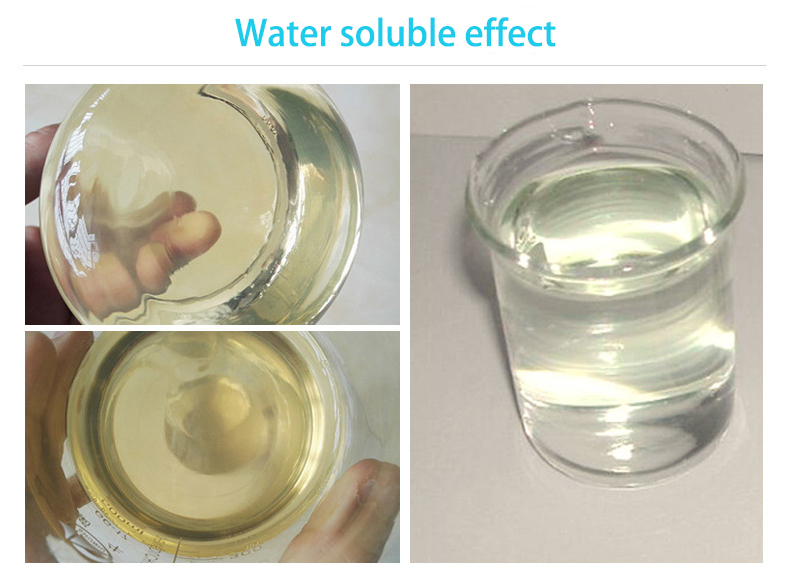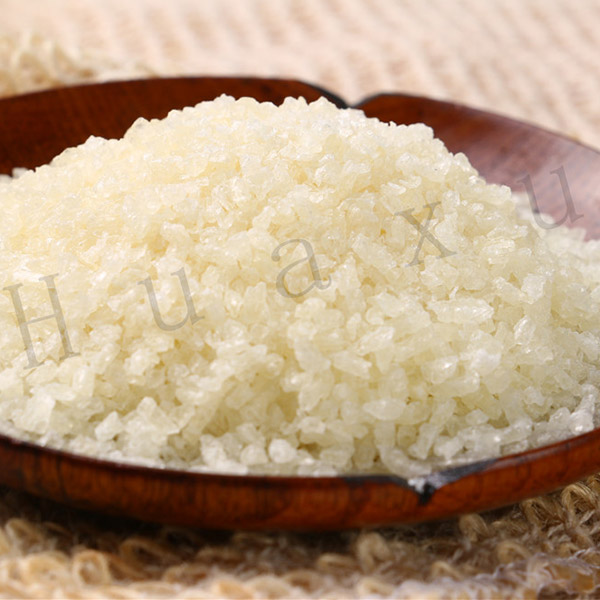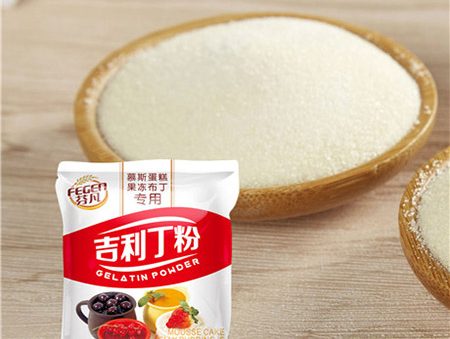
Gelatin for jelly
Gelatin can be divided into multiple categories, one of which is edible gelatin. It can be added to foods, such as jelly, cake, ice cream, etc. Adding gelatin, for example, makes jellies stretchy and replenishes the collagen our bodies have lost.
Specification of jell gelatin
| Product Name | gelatin | Net weight | 5 tons | |
| Standard | GB/T6783-2013 | |||
| Appearance | Light yellow to yellow granule | |||
| Inspection items | Unit | Standard | Test result | |
| Jelly Strength (6.67%, 10 ℃) | Bloom.g | ≥150 | 150-260bloom | |
| Engler Viscosity(6.67%, 40 ℃) | °E | ≥10 | 13.4 | |
| Viscosity degradation(6.67 %,37℃) | % | ﹤7.0 | 3.21 | |
| Luminousness | 450nm | % | ≥70 | 86.4 |
| 620nm | % | ≥90 | 95.6 | |
| PH | 4.0-7.2 | 5.6 | ||
| Moisture | % | 10-14 | 13 | |
| Ash Content | % | ≤2.0 | 0.76 | |
| Chromium | ppm | ≤2.0 | 0.2 | |
| Heavy metal | % | ≤0.003 | Meet the specification | |
| Arsenic salt | % | ≤1 | 0.01 | |
| Insoluble particles | % | ≤0.2 | 0.01 | |
| Peroxide | mg/kg | ≤10 | ﹤1 | |
| Total Bacterial Count | cfu/g | ≤10000 | ﹤10 | |
| Salmonella | 10g | negative | Not detected | |
| Colibacillus | g | ≤3 | ﹤0.3 | |
| Mucedine | Cfu/g | ≤100 | ﹤10 | |
| Conclusion | Passed | |||
Benefits of making jelly with gelatin
What’s in the homemade jelly? Only 2-3 natural ingredients are required. In homemade jelly, you can use fruit or vegetable juices, natural sweeteners (honey-this is a wise choice.) and grass-fed beef gelatin (note: not gelatin protein powder). I like to use fruit/vegetable mixtures, such as peach mango vegetable juice with beautiful orange gelatin, cranberry raspberry juice or blueberry pomegranate juice. You can even use freshly squeezed juice!
It tastes fresh, bright and beautiful, without any dyes or additives. The 3 ingredients (or 2 ingredients!) formula is very simple, all colors come from the beautiful natural colors of the juice of your choice. In addition, there are no refined sugars, artificial flavors or additives! Homemade jelly does not contain all major allergens-gluten, dairy products, eggs, soy, nuts, fish, etc. But it does contain gelatin derived from beef bones (so it is not vegan).
Production process of gelatin for jelly
The raw material of gelatin for jelly
1、 4 glasses of juice
2、 tablespoons of unflavored beef gelatin (such as Vital Proteins or Great Lakes. Do not try to use collagen or protein powder.)
3、2 table spoons of honey or agave (optional)
The process of gelatin making jelly
1. Add 1/2-3/4 cup of juice to a bowl or liquid measuring cup and sprinkle with gelatin powder.
2. Stir and mix together, and let it stand for 3-5 minutes to “flower”. The particles will be plump and the mixture will look like thick applesauce or lumpy.
3. Pour the remaining (1/4-1/2 cups) juice into a medium saucepan. Boil over medium heat.
4. Remove from the heat and add honey (if using) and blooming juice/gelatin mixture. Stir to dissolve.
5. Pour into an 8×8 (2 quart) thick jelly baking pan or 9×13 inch thin jelly baking pan, or put it into a separate glass or jar.
6. Refrigerate for about 4 hours, or until solidified. (If you are using a 9×13 pan, it may be set in just 2 hours)
Pay attention to making jelly with gelatin
This recipe must use unseasoned beef gelatin instead of protein powder, collagen or gelatin protein powder. Only gelatin will work.

Gelatin in jelly
Jelly is a kind of western sweets. It is semi-solid, with crystal clear appearance, bright color and soft taste. During holidays, many people will spare jelly at home, jelly is very popular among children. Jelly is water, sugar, thickening agent as the main raw materials, through sol, mixing, filling, sterilization, cooling and other processes processed jelly food.
Jelly is rich in high dietary fiber and rich in water-soluble semi-fiber. It can effectively expel heavy metal atoms and radioactive isotopes from the body, acting as a “gastrointestinal scavenger”. It can also effectively prevent and assist in the treatment of diseases such as hypertension, coronary heart disease, heart disease, diabetes, tumors, obesity and constipation. At the same time, in the jelly manufacturing process, need to add calcium, potassium, sodium and other minerals. These minerals are also needed by the human body.
Introduction of gelatin for jelly
At present, most edible gums/hydrocolloids used in jelly are gelatin. Gelatin is a natural polysaccharide edible gum/hydrocolloid extracted from natural Eucheuma and other seaweeds. It has the basic characteristics of soluble dietary fiber and is approved to be used in various foods in China.
Due to their excellent gel properties, high stability, safety and non-toxicity, gelatin, as additives that can be directly added to food, are approved by the food safety departments of various countries and can be widely used in the food industry. Gelatin powder generally accounts for about 1% of the jelly, accounting for about 5% of the total cost.
The nature and function of gelatin
The nature of gelatin
1、Physical and chemical properties
Gelatin is a high molecular hydrophilic polysaccharide extracted from red algae. Food grade gelatin is white to light yellowish brown, wrinkled surface, slightly shiny, translucent flake or powder, odorless or slightly odorless, tasteless, sticky taste, expansion in cold water, soluble in hot water above 60°C will form a viscous transparent or slightly milky white, easy to flow solution, but insoluble in organic solvents. When their isoelectric point is lower than or equal to their isoelectric point, they are easily compatible with alcohol, glycerin and propylene glycol. Reagents, low molecular weight amines and proteins are incompatible.
Due to the unbranched structure of gelatin macromolecules and their strong anionic properties, they can form a high-viscosity solution whose viscosity depends on the concentration, temperature, type of gelatin, and whether there are other dissolved substances. In addition, gelatin can also form a variety of different gels in water or milk-based food systems at low temperatures.
Gelatin has strong stability and is not easily degraded after long-term storage in dry powder state. Even if heated, it will not be hydrolyzed, but in acidic solutions (especially pH ≤ 4.0), gelatin is prone to acid hydrolysis, and the gel strength and viscosity are also reduced. It is worth mentioning that under neutral conditions, if gelatin is heated for a long time at high temperature, hydrolysis will also occur, resulting in a decrease in gel strength. Gelatin can solve in hot water and hot milk. After being dissolved in hot water, it can form a viscous transparent or milky white fluid solution. It is worth noting that: Gelatin can only swell by absorbing water and cannot dissolve in cold water.
2、Rheological properties of gelatin
Based on the properties of gelatin, gelatin is usually used as a thickener, gelling agent, suspending agent, emulsifier and stabilizer in the food industry. The production and application of these gelatins are closely related to the rheological properties of gelatin. Therefore, it is of great significance to accurately grasp the rheological properties of gelatin and its changing laws under various conditions.
The viscosity of the solution increases exponentially with increasing concentration, and decreases exponentially with increasing temperature. In the steady state, the relationship between viscosity and temperature is reversible, but the slope of the “viscosity-temperature” curve is different during heating and cooling, and the slope of the curve is smaller when the temperature rises. That is caused by hysteresis. When the temperature drops to 30°C, the viscosity increases dramatically as the gelatin molecules gradually begin to intertwine into a network structure. When the temperature is lowered, K-gelatin is mixed. The viscosity of L-gelatins suddenly increases when they reach their gel point; this is not the case with λ-gelatins. Heating at a constant temperature also affects the viscosity of the gelatin solution.
At 75°C, with the extension of the constant temperature time, the viscosity of the gelatin solution decreases, because the colloidal macromolecules dissociate with the heating of the solution, and the molecular entanglement decreases, so the viscosity decreases. At 100℃, viscosity decreases with time. The reason is that, at first, the entanglement between the molecules is interrupted by high temperature and the viscosity is reduced. After that is a relatively mild phase, then a few stable macromolecules begin to degrade, and the viscosity drops again.
The viscosity of the gelatin solution increases with the increase of pH, and is basically stable when it is close to neutral, and then decreases. Increased acidity and increased hydrogen ions promote the dissociation of gelatin molecules and neutralize their electrical properties, weakening the electrostatic attraction between half-esterified sulfates. The alkalinity is enhanced, and the hydroxide ions repel the negatively charged gelatin to reduce the entanglement of the molecular drop. Therefore, under strong acid and strong alkali conditions, the viscosity of the solution will decrease. When certain cations are present in the solution, the viscosity of the solution will decrease. This is because cations reduce the electrostatic attraction between semi-esterified sulfates.
The role of gelatin in the food industry
The application of gelatin in the food industry mainly manifests itself in three aspects: gelling, thickening and protein reactivity.
The reaction of gelatin with protein
The protein in the solution gathers to form protein micelles. Gelatin is free in solution and reacts with exposed amino acid fragments of the protein. According to the concentration and pH value, aggregation, precipitation, suspension and gelatine occurred respectively. In meat, the solid proteins are salted (pickled, rolled) and heat treated, and react with each other to form protein networks. Gelatin can strengthen this structure through interaction with the protein.
Therefore, after gelatin can absorb protein molecules in the protein solution, the protein solution can be suspended and stabilized. Practical applications are stabilizers for dairy beverages and emulsifying stabilizers for ice cream to stabilize and thicken milk protein solutions.
Gelatin powder and leaf gelatin
There are many types of gelatin. beef gelatin, gelatin powder & leaf gelatin.
Wholesale gelatin for capsules
Our wholesale gelatin is slightly yellow to yellow, transparent or translucent microstrip luster flakes or powder
Gelatin for candy – edible gelatin
In the food industry, edible gelatin is used as an additive in confectionery. Gelatin candy.
Halal beef gelatin powder
Gelatin have many usage. Gelatin have edible gelatin, industrial gelatin





